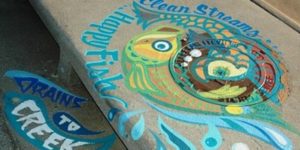
The initial idea was a relatively common one: use concrete to replicate the look of stone. But as is often
the case, this project design was not as simple as it seemed.
The original design intent for the flatwork of the newly renovated California Firefighters Memorial in Sacramento, Calif. called for a sub-slab and a mortar set three-foot by five-foot sized stone paver placed in a running bond pattern.
However, budget constraints and scheduling concerns left the design team looking for a substitute for the stone. They found their solution with Trademark Concrete out of West Sacramento, Calif.
“Our job, as a valued trade partner and specialist in decorative concrete, was to provide critical expertise and innovative solutions to make the project feasible,” said Michael Campbell, Vice President at Trademark.
 |
 |
As one of California’s top decorative concrete construction companies, Trademark Concrete is well versed in designing stone alternatives and working with stakeholders during the design process.
“While we have often been called upon to provide value engineering options, achieving consensus among the client, design team, and contractor is often a challenge. This project was different,” said Campbell. “From the outset, the California Fire Foundation design team, Lionakis and Romo Studios, and general contractor Turner Construction were unified in their openness to the potential of decorative concrete as a cost-effective and visually striking alternative. All key stakeholders fully embraced the idea of replacing stone with decorative concrete.”

Trademark’s first task was to dial in the color of the concrete to match the original white hue of the specced stone.
“We originally thought we’d just use white cement instead of gray, but we weren’t getting the right result,” said Michael Campbell, Vice President at Trademark. “It was too white.”
After many attempts, they finally figured out the perfect recipe. A mixture of gray cement from Cemex, white sand from Salinas, Calif. and a Bone color hardener from SikaColor.
“By the end of the process, if you had the stone in one hand and the concrete sample in the other, it would be very hard to tell the difference between the two,” Campbell said.
 |
 |
Next, Trademark and the rest of the team had to figure out how to create the same running bond paver pattern without compromising the integrity of the concrete slab.
“One of the big design points was that originally the project was specced as a three-foot by five-foot stone paver, all set in a running bond pattern. You can’t just [pour a slab and] cut the concrete that way to match the specs correctly,” Campbell explained, as the saw cuts cannot end at another saw cut.

The solution was rather complex. Essentially, Trademark had to form multiple three-foot-wide lanes and pour the concrete in alternating bands. By only pouring in every other lane, it allowed them to place the cuts every five feet as the design called for, without compromising any function of the control joints.
Despite having to pour the concrete in alternating sections, the final result had to be visually seamless between the two pours. Trademark used a 3/16-inch diamond blade to trace a joint between each pour, as well as the cuts needed to imitate the stone look. By doing so, they did not need to use polymeric sand in the joints, which made for a seamless, uniform look.
 |
 |
“All the line work is identical,” Campbell said. “It looks just like pavers.”
Grace Top-Cast surface retarder was then broadcast on and pressure washed off the following day in order to expose the white sand to get the correct color.

In addition to the 10,000 square feet of flatwork, Trademark was also responsible for creating the vertical elements in the same white hue. This included seating walls, pedestals for bronze statues, and the structure for the ax walls, which were designed to look like ax handles from a birds-eye view. The new ax walls surround the original wall of the memorial, which was originally unveiled in 2002. After construction, the new walls were covered in limestone and are host to the names of over 1,500 fallen firefighters in California since statehood in 1850. Each year, the Firefighters Foundation sandblasts new names of those who died in the line of duty into the limestone during a special ceremony.
Throughout the project, Campbell noted how unified the entire team was.
“The collaboration between all stakeholders exemplified the power of partnership and innovation,” he said.
Even the local firefighters had a vested interest in the day-to-day operations.
“The Sacramento Fire Chief was on the job every day,” Campbell said. “They had actual firefighters setting all the statues with the cranes and the rigging. It was definitely more of a team atmosphere.”




















